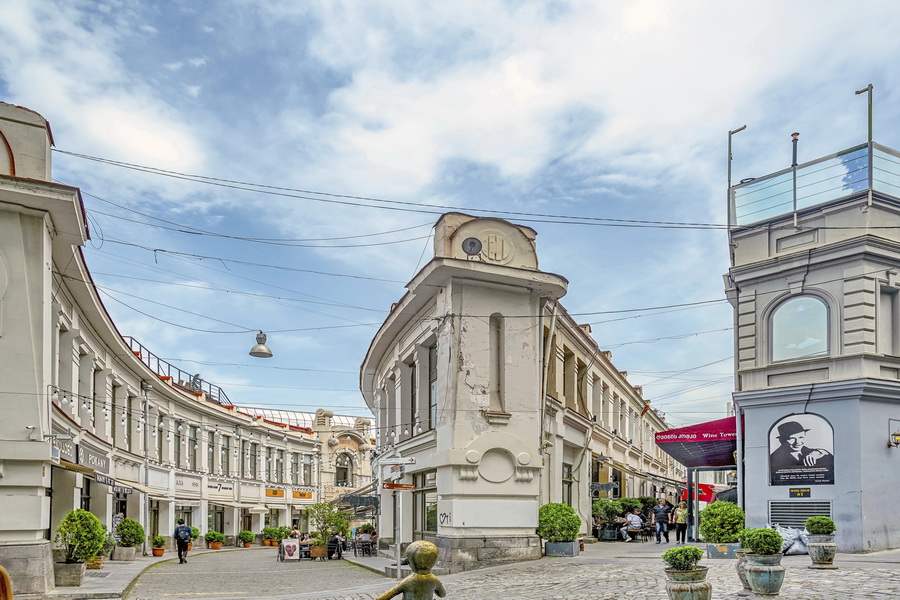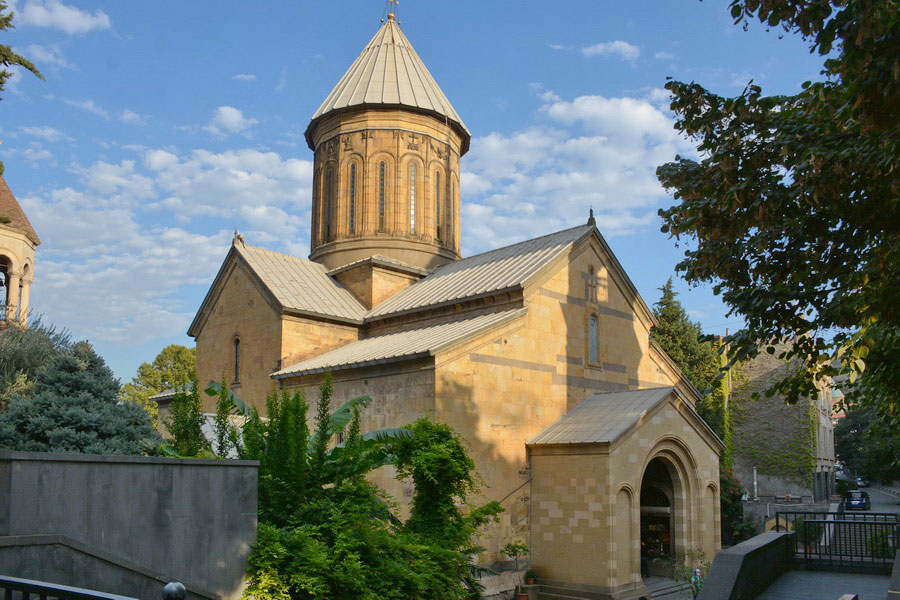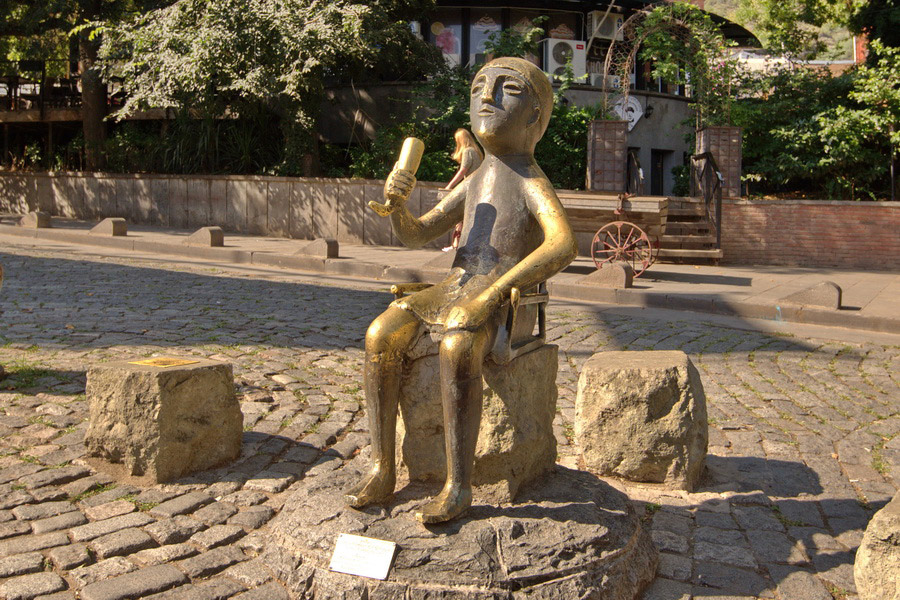
Shardeni Street is a popular tourist area in the heart of Tbilisi, lined with authentic restaurants, atmospheric bars, and stylish nightclubs. During the warm season, the area is always lively and bustling, and in the evenings, the streets of this romantic quarter come alive with music, laughter, and the mouthwatering aroma of local cuisine. The soft glow from cozy cafes seems to beckon passersby, while the clinking of glasses and heartfelt toasts echo from open-air terraces.
History
The area stretching from today’s Sioni cathedral to Meidan square was once a maze of narrow alleys packed with shops and artisan workshops. These rows of storefronts, winding along the banks of the Kura River, were shaded by dense fabric awnings that shielded them from the scorching sun and seasonal rains, plunging the commercial warren into a cool dimness. This unique atmosphere gave rise to the nickname “Dark Rows”.
Each alley had its own name reflecting the type of trade practiced there: for instance, Iron Street specialized in metal goods, while Cotton Street dealt in textiles. Together, they formed a clearly structured trading zone organized by commodity. Until the early 20th century, the quarter covered a much larger area than it does today, encompassing present-day Sioni square, the beginning of Kote Abkhazi Street, and a substantial portion of the riverbank. In size, it was nearly twice its current footprint.
A notable chapter in the history of Shardeni street is the 1850 visit by the heir to the Russian throne, Grand Duke Alexander Nikolaevich, later Emperor Alexander II. While in Tiflis, he attended a formal reception hosted by the Armenian community at the Artsruni caravanserai, a key center of urban life. Following the banquet, the prince took a stroll through the surrounding streets, symbolizing the imperial government’s interest in this vibrant, multicultural commercial hub.
Name
The name of the quarter is linked to the French traveler Jean Chardin, who passed through Tbilisi in 1672–1673 on his way to Persia via Istanbul, Crimea, and the South Caucasus. During his journey, he visited Imereti, Megrelia, Adjara, and Tbilisi, where he vividly described the famous “Dark Rows” in his diary. He noted their vibrant atmosphere and the distinctive character of an oriental bazaar - impressions that later inspired the naming of Shardeni Street.
Sights

Sioni Cathedral is one of the most significant spiritual and historical landmarks in Tbilisi. Named after Mount Zion in Jerusalem, it served for centuries as the main cathedral of the Georgian Orthodox Church (a role later transferred to Sameba Cathedral - the Cathedral of the Holy Trinity - in 2004). The cathedral holds the cross of Saint Nino, the enlightener of Georgia, whose pious life played a pivotal role in the Kingdom of Kartli’s adoption of Christianity in the 4th century.
Artsruni Caravanserai is another notable architectural monument in the area, located close to Sioni Cathedral. Built in the first half of the 19th century by Armenian nobleman Gevorg-aga Artsruni, it functioned as both a commercial hub and a temporary lodging for merchants and travelers traversing the Caucasus. The caravanserai’s architecture reflects a blend of Eastern and Georgian styles, with a spacious courtyard surrounded by arched galleries, thick stone walls, and ornamental façades.
This building holds a key place in the historical evolution of the neighborhood and is one of the few remaining examples of 19th-century commercial architecture. Due to its central location, it served not only as a marketplace but also as a gathering space for people of various cultural backgrounds.
Today, the restored structure houses the Tbilisi History Museum. The museum’s extensive exhibition spans from ancient archaeological finds to artifacts from the urban life of the 19th and 20th centuries. Its collection showcases items that reflect Tbilisi’s economic, cultural, and social history - including household tools, crafts, documents, photographs, musical instruments, and rare objects such as a 19th-century road cart and an early typewriter. The museum remains actively involved in both research and exhibitions, preserving the memory of the capital’s enduring heritage.
Sioni Square is another key attraction in the Shardeni district. At its center stands a monument to the celebrated Georgian actress Sofiko Chiaureli. This bronze composition, created by sculptor Levan Vardosanidze in 2009, portrays the actress in several of her most iconic roles - including Fufala from The Tree of Desire, the laundress Vardo from Melodies of the Veria Quarter, and characters from other films. The monument was inspired by a scene from Sergei Parajanov’s cinematic masterpiece The Color of Pomegranates. Nearby on Sioni Street stands another notable sculpture known locally as “Tamada” - a large-scale replica of a bronze figurine uncovered at the Vani archaeological site.

Sioni Square is also a vibrant focal point for city celebrations. Every year in late May, the Tbilisi Flower Festival is held here, coinciding with Georgia’s Independence Day. During the festival, the square and nearby streets are adorned with elaborate floral installations, creating a joyful and festive ambiance.
Mantashevsky Rows are two buildings constructed in 1904 in central Tiflis at the behest of wealthy Armenian oil magnate Alexander Mantashev. Designed to accommodate retail pavilions, they once offered textiles, household goods, tableware, carpets, jewelry, and foodstuffs. These arcades replaced the older “Dark Rows” - the intricate tangle of shops and workshops that formerly occupied the site. Seamlessly integrated into the city’s architectural fabric, the Mantashevsky Rows have become an enduring feature of Shardeni Street.
Shardeni Street Today
Shardeni Street is best known today as a vibrant hub for evening entertainment. The area offers a wide range of venues, from intimate wine bars and jazz clubs to sleek lounge spaces featuring electronic music. Summer terraces invite wine enthusiasts to sample both well-known and lesser-known Georgian vintages in a relaxed, sociable atmosphere. Alongside traditional Georgian eateries, visitors will also find restaurants serving Italian, French, and Pan-Asian cuisine.
But the appeal of Shardeni Street extends beyond dining and drinking. Many local bars and cafes regularly host live music performances, karaoke nights, and communal screenings of major sports events, creating a dynamic and engaging social scene.

